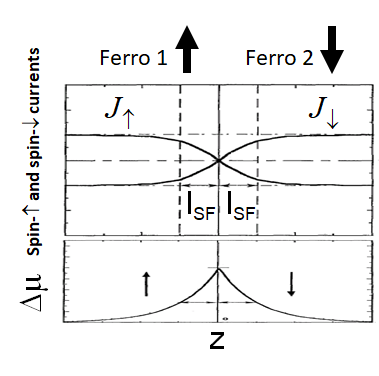Spin accumulation phenomena frequently occur in spintronic devices due to the difference of electrical resistivities of spin-up and spin-down electrons in magnetic materials. They are balanced by spin relaxation phenomena. These phenomena take place in a diffusive regime which involves numerous individual scattering events. Consequently, although the time scale of elastic electron scattering in metals is in the femtosecond range, the dynamics of spin accumulation/relaxation phenomena in spintronic devices can be of the order of picosecond. This can have important impact on the performances of spintronic devices operating in THz range.
In transition magnetic metals (Fe, Co, Ni and their alloys), conduction electrons carry the current differently depending whether their spin is aligned parallel (spin-up) or antiparallel (spin-down) to the local magnetization (spin-dependent scattering). For instance in Co, spin-up electrons carry ten times more current than spin-down electrons. If a current traverses a structure comprising two such magnetic layers, the current flow will strongly depend on the relative orientation of the magnetization in the two layers. When the magnetization of the two layers is antiparallel (Fig.a), one species of electrons carry most of the current in one magnetic layer while the opposite species carry most of the current in the other layer. This results in spin accumulation around their interface, balanced by spin relaxation effects. The spin-dependent scattering and associated spin accumulation/relaxation is at the origin of the current-perpendicular-to-plane giant magnetoresistance observed in magnetic metallic multilayers (stacks of alternating magnetic and non-magnetic layers) as well as in lateral spin-valves (devices consisting of magnetic patterns interconnected by non-magnetic conducting channels). These phenomena take place in diffusive regime and results from numerous individual elastic scattering events. In the present theoretical studies, it was shown that although elastic scattering times in metals are in the range of femtoseconds, the time scale of spin accumulation variation can be significantly larger, especially in lateral spin-valves in which the spin conducting channels can be micron long. In such case, spin accumulation can build up on time scale of the order of picosecond. Nowadays, spintronic devices are proposed which operate in the THz range. They are often based on antiferromagnetic or ferromagnetic materials. According to the present study, their electrical response and in particular their magnetoresistance can strongly depend on the frequency at which they are operated as illustrated in Fig.b. These dynamics effects are important to take into account in the understanding of the properties of THz devices and in their optimization.
Teams: MRAM, Theory and simulations
Funding: ERC MAGICAL n°669204
Further reading: Spin accumulation dynamics in spin valves in the terahertz regime, A.Vedyaev, N.Ryzhanova, N.Strelkov, A.Lobachev and B.Dieny, Phys.Rev.B, 101, 014401 (2020).
Contact: Bernard Dieny
Figure: a) Representation of the spin current and spin accumulation at the interface between two ferromagnetic layers in antiparallel magnetic configuration. b) Evolution of the giant magnetoresistance amplitude (GMR) in a model structure of the form Ferro1 50nm/NM 500nm/Ferro2 50nm/NM 500nm as a function of the frequency at which the relative orientation of the magnetization of two magnetic layers is changed.

